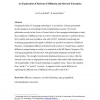26354 search results - page 178 / 5271 » How we refactor, and how we know it |
FPCA
1995
14 years 2 months ago
1995
Lenient languages, such as Id90, have been touted as among the best functional languages for massively parallel machines AHN88]. Lenient evaluation combines non-strict semantics w...
AAAI
2008
14 years 1 months ago
2008
Heuristic search using algorithms such as A and IDA is the prevalent method for obtaining optimal sequential solutions for classical planning tasks. Theoretical analyses of these ...
CORR
2010
Springer
13 years 11 months ago
2010
Springer
Two mobile agents (robots) with distinct labels have to meet in an arbitrary, possibly infinite, unknown connected graph or in an unknown connected terrain in the plane. Agents ar...
CORR
2010
Springer
13 years 10 months ago
2010
Springer
Grasping the fruits of "emerging technologies" is an objective of many government priority programs in a knowledge-based and globalizing economy. We use the publication ...
IJNM
2008
13 years 10 months ago
2008
Routing protocols for mobile ad hoc networks (MANETs) have been an active area of research for the last decade, with many very interesting potential as well as actual applications...

